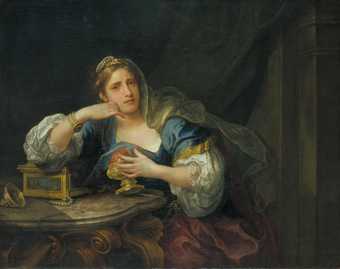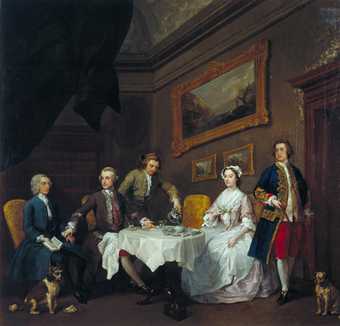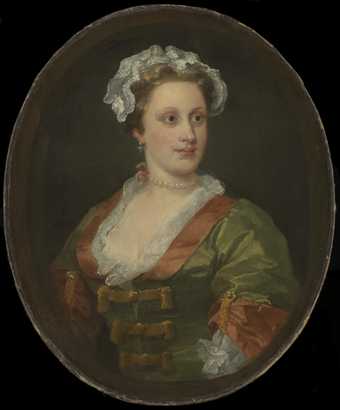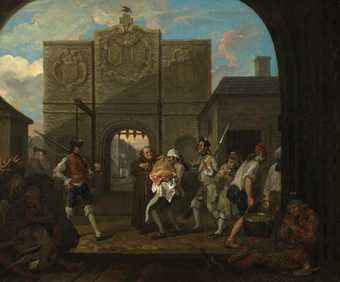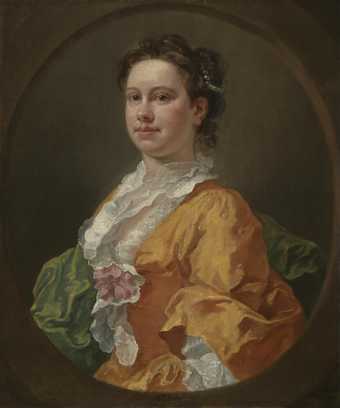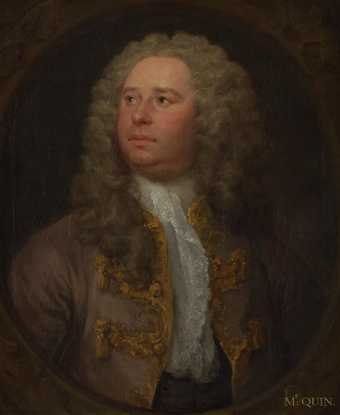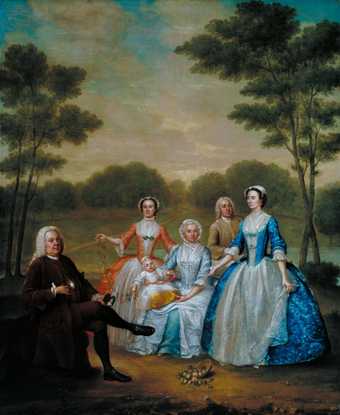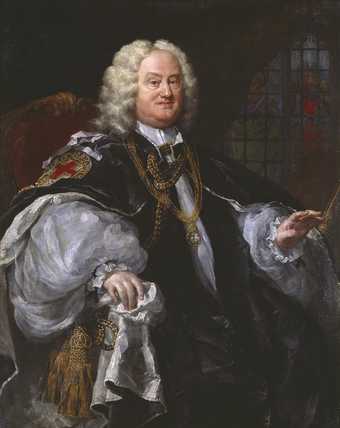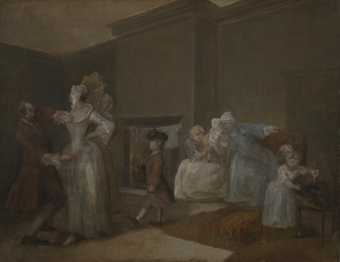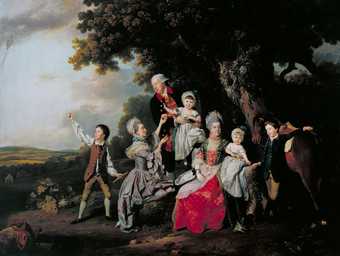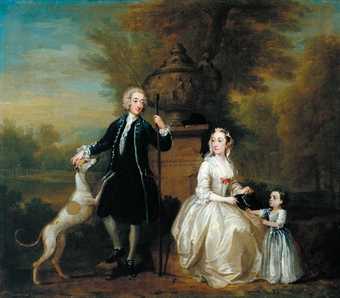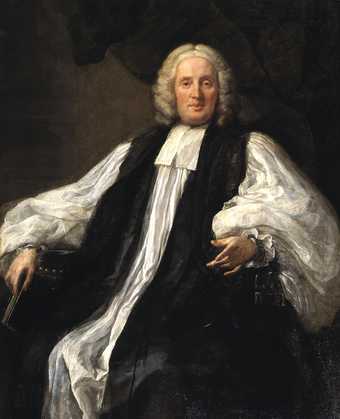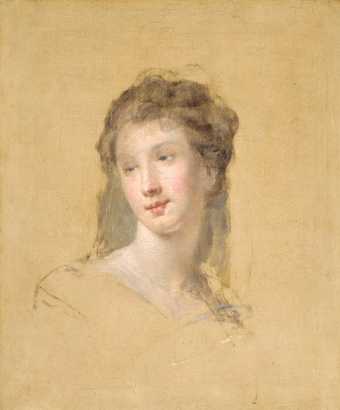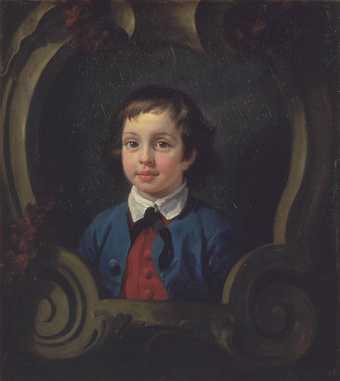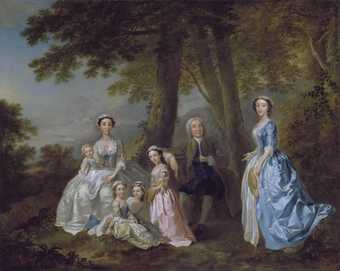
In Tate Britain
- Artist
- William Hogarth 1697–1764
- Medium
- Oil paint on canvas
- Dimensions
- Support: 630 × 755 mm
frame: 883 × 1009 × 60mm - Collection
- Tate
- Acquisition
- Purchased 1892
- Reference
- N01374
Display caption
This group portrait may have hung in Hogarth’s studio, serving as an advert for his skill in painting. Anyone visiting Hogarth’s house would have been met by his servants. On entering his studio, they could then compare Hogarth’s painted portraits with the real person. The aim would have been to impress, especially anyone considering having their own portrait painted. It demonstrates his ability to capture a likeness in all age groups. Portraits of servants from this period are rare. Hogarth’s decision to paint his servants in this way is unique.
Gallery label, December 2020
Does this text contain inaccurate information or language that you feel we should improve or change? We would like to hear from you.
Catalogue entry
N01374 Heads of Six of Hogarth's Servants c.
1750–5
Oil on canvas, 630×755 (24 1/16×29 1/4)
Purchased by the National Gallery (Lewis Fund) 1892; transferred to the Tate Gallery 1960
PROVENANCE Mrs Hogarth, from whom inherited by her cousin Mary Lewis 1789, sold Greenwood's 24 April 1790 (44 as ‘The heads of 6 servants of Mr. Hogarth's family’) £5 15s 6d bt ‘Clarke, Strand’, possibly for William Collins of Greenwich, by whom lent to BI in 1817 and Suffolk Street Gallery in 1833; ...; c. 1863 part of stock-in-trade of William Benoni White, sold Christie's 24 May 1879 (244) bt J.K. Wedderburn, sold Christie's 3 June 1892 (98) bt C. Fairfax Murray for the National Gallery
EXHIBITED BI 1817 (80); British Artists, Suffolk Street Gallery, Winter 1833 (214); Twe Eeuwen Engelsche Kunst, Stedelijk Museum, Amsterdam 1936 (65); La Peinture Anglaise, Louvre, Paris 1938 (67, repr.); BC tour 1946 (3); BC tour 1949 (62, repr.); Manchester 1954 (38); Tate Gallery 1971 (197, repr.)
LITERATURE Nichols 1782, p.88, 1785, p.98; Nichols & Steevens, II, 1810, p.iv, III, 1817, pp.173*–4*, 197; Nichols 1833, p.383; G. Redford, Art Sales, 1888, II, pp.297–8 (for Benoni White Sale); A. Dobson, ‘The New Hogarth at the National Gallery’, Illustrated London News, 2 July 1892, repr.; Dobson 1902, pp. 130, 148, 161, 182, repr. p.15, 1907, pp. 146, 188, 215, repr. facing p. 146; ‘Mrs Hogarth's Sale’, Burlington Magazine, LXXXV, 1944, p. 258; Davies 1946, p.70; Beckett 1949, p.44, pl.194; Waterhouse 1953, pp. 133–4, pl. 105; Davies 1959, p.68; Antal 1962, pp. 173–4, 249 n.45, pl. 132; Baldini & Mandel 1967, p.112, no. 177, pls. LX-LXI (col.); Paulson 1971, II, pp. 244–6, pl.264; Waterhouse 1978, p.179, fig.141; Webster 1979, pp. 142, 187, no. 162, repr. in col. p.143; Bindman 1981, p. 195, fig. 156. Also repr.: W. Gaunt, The Great Century of British Painting: Hogarth to Turner, pls. 30, 31 (detail)
One of Hogarth's most spontaneous and masterly works in portraiture, this sketch represents, according to reliable sources, six servants of the Hogarth household. It is not known who they are individually, but Samuel Ireland (1794, p.169) mentions that the Hogarths had an old servant called Ben Ives, who could be the old man in the top right corner. Mrs Hogarth is also known to have had a servant called Samuel, and a housemaid who was with them at Chiswick, a ‘Mrs Chappel, of Great Smith Street, Westminster’, who lived to be a centenarian well into the nineteenth century. Some of Mrs Chappel's recollections were used in Edward Draper's ‘Memorials of Hogarth’, Pictorial World 26 September 1874 (quoted in Paulson 1971, II, pp.451–2 n.74). The painting may have hung in the artist's studio along with other portraits of his family, and could have served to demonstrate his ability to catch a likeness in all age-groups - indeed, the range of flesh tones represented is remarkable.
Although the informal directness of the group clearly puts it into the category of ‘friendship’ portraits, painted either for the sheer love of painting or out of affection for the people represented, or both, it could also be seen as a realisation in painterly terms of the kind of categorising accumulation of heads and objects that are frequent in Hogarth's graphic work and which aim to express the full range of some given concept, in this case all the facial characteristics from youth to age as in the ‘seven ages of man’, a subject already dealt with by him in the surround of Plate 2 of The Analysis of Beauty, 1753.
It is not possible to date the work exactly, but stylistically it would appear to be fairly late. The beginnings of a seventh head, probably female, have been laid-in in the lower left corner, and the left-hand edge of the young woman's bonnet next to it has been narrowed as if to accommodate it. The left edge of the canvas has been cut, removing half of the oval of the laid-in head. The remaining heads have been brought to a high degree of finish, although their placing on the buff ground makes it clear that the painting was never meant to be taken any further. Compositionally, however, the painting is given an overall unity by all the heads being lit from the same side, and each is loosely paired in the angle from which it is seen with the head above or below. At the same time each maintains its separateness by looking out at its own distinct focal point, and the fact that none of their lines of vision intersect creates a sense of balanced dignity unusual in a painting that makes no apparent claim to being a formal composition.
The painting is first mentioned by Nichols in 1782, who, when commenting on Hogarth's good relations with his servants, states: ‘of most of these he painted a strong likeness on a canvas still in Mrs Hogarth's possession’. It was bought at the sale of her collection in 1790 (according to Horace Walpole's annotated copy of the catalogue, published in the Burlington Magazine, LXXXV, 1944) by ‘Clarke of the Strand’. As Nichols & Steevens name the owner of the painting in 1810 as ‘William Collins Esq, of Greenwich’, and state in the subsequent (1817) volume that he had bought it at Mrs Hogarth's sale, it is likely that Clarke was his agent. The lender to the 1833 exhibition is mentioned only as ‘Collins’, so that it could be the same owner, or his descendant. After this the painting reappears in the 1879 sale of the stock-in-trade of the late William Benoni White, dealer in Brownlow Street, Holborn, where it had apparently ‘remained for the last sixteen years since his retirement from business’ (Redford 1888, quoting The Times, 28 May 1879).
Dobson records (Illustrated London News, 1892) that among the volumes of papers formerly owned by Hogarth's patron James Caulfield, 1st Earl of Charlemont, then currently on sale at Quaritch's, was a pencil drawing of this painting, signed with the initials of the etcher Richard Livesay, dated 1788, and entitled ‘Hogarth's Servants’. As Livesay was Mrs Hogarth's lodger at Leicester Square and produced many facsimiles after Hogarth's drawings for her, this seems reliable evidence, although no etching seems to have been produced after this drawing.
Published in:
Elizabeth Einberg and Judy Egerton, The Age of Hogarth: British Painters Born 1675-1709, Tate Gallery Collections, II, London 1988
Explore
- objects(23,571)
-
- clothing and personal items(5,879)
-
- hat, bonnet(211)
- group(4,227)
- groups(310)
- birth to death(1,472)
-
- stages of life(79)
You might like
-
William Hogarth Sigismunda Mourning over the Heart of Guiscardo
1759 -
William Hogarth The Strode Family
c.1738 -
William Hogarth Lavinia Fenton, Duchess of Bolton
c.1740–50 -
William Hogarth O the Roast Beef of Old England (‘The Gate of Calais’)
1748 -
William Hogarth Mrs Salter
1741 -
William Hogarth James Quin, Actor
c.1739 -
Stephen Slaughter The Betts Family
c.1746 -
William Hogarth Benjamin Hoadly, Bishop of Winchester
1741 -
William Hogarth The Staymaker (? The Happy Marriage V: The Fitting of the Ball Gown)
c.1745 -
Johan Zoffany The Bradshaw Family
exhibited 1769 -
William Hogarth Ashley Cowper with his Wife and Daughter
1731 -
William Hogarth Thomas Herring, Archbishop of Canterbury
1744–7 -
William Hogarth Head of a Lady, Called Lady Pembroke
c.1740 -
William Hogarth Portrait of George Osborne, later John Ranby Jnr
c.1748–50 -
Francis Hayman Samuel Richardson, the Novelist (1684-1761), Seated, Surrounded by his Second Family
1740–1

